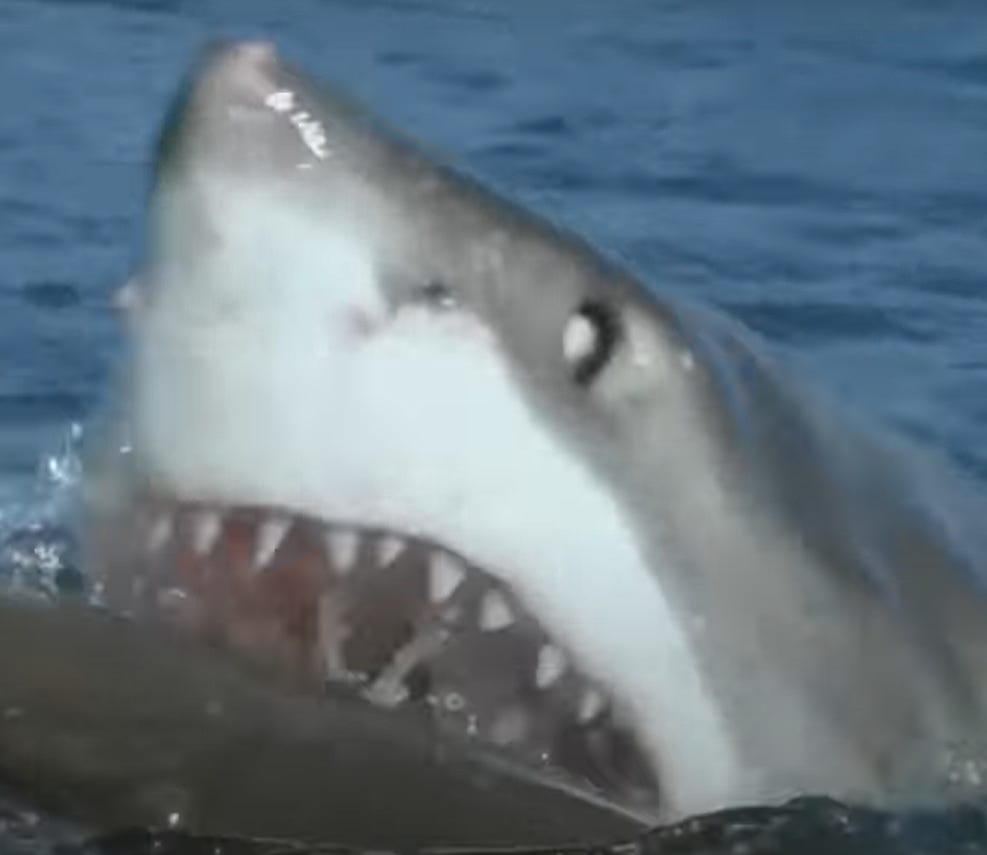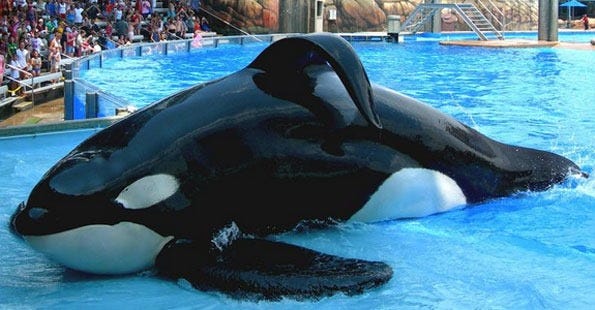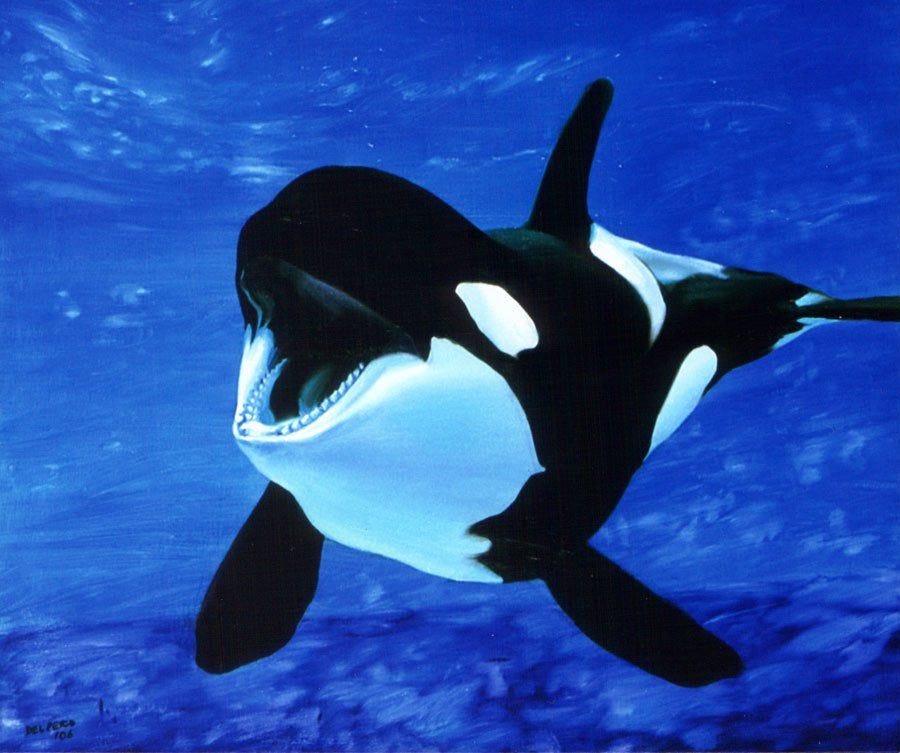Visit the Evidence Files Facebook and YouTube pages; Like, Follow, Subscribe or Share!
Find more about me on Instagram, Facebook, LinkedIn, or Mastodon. Or visit my EALS Global Foundation’s webpage page here.
Stephen Spielberg’s movie Jaws forever cemented the Great White Shark’s reputation as the single-minded killer of the seas. The real world creature instills as much terror as the movie portrayed. Built for hunting, the Great White shark is huge. Spanning 11 to 19.1 feet long (3.4 to 5.8 meters), and weighing up to 4,400 pounds (2,000 kg), this behemoth can reach speeds up to 16 mph (25km/h) and dive as deep as 3,900 feet (1,200 m). Scientists estimate the Great White’s bite force at around 4,000 psi—five times that of the strongest dog. Adding to its bulk, this beast sports row upon row of serrated, triangular-shaped teeth. Over its life, the shark continuously grows new teeth, which push out the older more worn ones, providing it with a lifelong array of freshly sharpened tools for killing. Great Whites can detect electromagnetic fields, a feat called electroception, allowing them to find hidden prey—even those buried in the sand! In addition, their eyes are larger than most shark species, and they are blue. To protect those delicate eyes, sharks roll them back in their skull while attacking, which gives them an even fiercer visage (as if they needed it!).
Source: BBC
Great White sharks are extraordinary, and terrifying. But if you thought this story was about some rogue shark slaughtering beachgoers in some wayward seaside town, you would be mistaken. No, dear readers, the Great White isn’t the hunter in this tale… in fact, it is the hunted. And this is not yet another story of human depravity; there are plenty of those for another day.
Meet Port and Starboard
Port and Starboard are two male orcas—killer whales—who have given a whole new meaning to their iconic name. Technically more closely related to dolphins, killer whales (ballena asesina) acquired that name based on early mariners’ mistaken belief in their propensity to kill actual whales. This pair stalks the seas off the coast of South Africa killing Great Whites like it is their job, and they’re pining for a raise. Dave Hurwitz, owner of Simon’s Town Boat Company in the Western Cape, is credited with naming this fearsome duo. He told Getaway magazine that the pair first arrived in the area in 2015. Hurwitz gave them the names because each of the two males shares an extremely rare trait among orcas in the wild. Their massive dorsal fins flop to the side—one to the left, or port, and one to the right, starboard. Collapsed dorsal fins commonly occur in captive killer whales. Tilikum, the infamous destroyer of trainers, who was held at SeaWorld in Florida for most of his tragic life, brought public attention to this condition after Gabriela Cowperthwaite featured him in the documentary Blackfish. Normally, male orcas’ dorsal fin sores upward as high as six feet (~2 m). In captivity, some researchers believe that stress, unnatural environmental conditions, or food sources might cause the collapse of the massive fin. In the wild, scientists can only speculate about the reason as the phenomenon is so rarely observed. The rarity of the condition, however, has enabled observers of these two killers to easily identify them.
Tilikum. Source: The Kimmela Center
Before discussing the parade of carnage these two conduct, let’s compare the specs of an orca to a Great White. Male orcas range in size from 20 to 26 feet (6 to 8 m) long, and weigh in at 10 to 12 tons. So, while almost twice as long as a larger Great White, orcas are nearly 10 times heavier. And they’re faster. Twice as fast, in fact. Like sharks, orcas have conical teeth, anywhere from 40 to 56 of them, each around 4 inches long that interlock when they close their jaws. Orcas’ bite force makes the Great White look wimpy. Compared to the shark’s seemingly impressive 4,000 psi, orcas chomp down at an astonishing 19,000 psi. But these incredible features pale in comparison to the orca’s true strength—its intellect. Orcas live in communities called pods, each with its own distinct language (technically, dialect), and the species lives in every ocean in the world. The variability among orcas’ adopted living environments has required them to create locally-engineered hunting practices, which are studiously passed on from generation to generation. And their techniques are nothing short of brilliant. Watch the video below to see how one pod learned to track the tides to gain direct access to their prey. Warning: graphic content.
In the battle between mammal and fish, the fish—even one as fearsome as the Great White—clearly suffers the disadvantage. The war waged by Port and Starboard on South Africa’s Great Whites offers no exceptions.
No one knows why the pair started hunting the waters of False Bay, though some have speculated that changes in the offshore environment, available food sources, or their age, may have had something to do with it. Before their arrival, False Bay famously contained hundreds of Great Whites. Then came the serial killer tandem. Researchers cannot definitively confirm that the massive reduction since 2015 of the population of Great Whites in the bay was solely caused by Port and Starboard, but the numbers line up. Nevertheless, whether the two are the sole cause or not, there is no question that they comprise a significant factor.
Scientists have known orcas kill sharks for decades. Research indicates orcas seek the highly nutritious livers, which is supported by the fact that many sharks killed by them are not otherwise eaten. Port and Starboard seem to have settled in a location where they can regularly, and easily, obtain this delicious and healthy morsel. What’s fascinating about these two, though, is the zeal with which they pursue their marks. In March of this year, for instance, marine scientists credited the two with killing and de-livering (wordplay alert) up to 17 sharks in a single day. They wrote on their Facebook page about the attacks that took place in just one area adjacent to False Bay that day:
Port and Starboard, known to prey on several species of sharks in South Africa, were tracked by a team of scientists on board Marine Dynamics vessel.
“We observed the two orcas repeatedly diving down in a small area for almost two hours before they departed offshore,” said Ralph Watson, @MarineDynamicsAcademy. The following Tuesday, eleven deceased Broad nose seven-gill shark carcasses were retrieved from the same beach by Watson and the MDA team.
Alison Towner, PhD candidate at Rhodes University leads the research on killer whales preying on sharks in Gansbaai. She joined Watson to perform the necropsies with the students. “This research is part of a coordinated effort between various killer whale and shark scientists; it has been ongoing since 2015,” said Towner. “Each seven-gill shark was torn open and missing its liver; they were all females measuring between 1.6-2.3 meters and had similar injuries to those killed in False Bay by the same orca pair”.
Storm and surge conditions early in the week provided good conditions to push the shark carcasses on shore. “This is the largest amount of sharks these orcas have killed in this area in one sitting,” says Towner, “There could well be more that didn’t wash out”.
When orcas approach a Great White, the shark adopts a curiously similar strategy that its own prey uses. Rather than flee—a likely pointless venture given that orcas are so much faster—the shark circles while keeping a cautious eye on the orcas. Unfortunately for the shark, these orcas work as a cunningly strategic pair forcing it to focus on just one of them at a time. When its attention is diverted to one, the other strikes. In larger groups, the odds shift even further. Here’s a video of several orcas attacking and killing a large Great White, where Starboard himself led the assault. Again, be warned of graphic content!
A 2022 study in the African Journal of Marine Science noted that in the first year of their analysis—2017—Port and Starboard killed 4, maybe 5, Great Whites and consumed only their livers. Each year after, the number rose, culminating in 17 in a single day (noted above) and reaching 20 sharks within the next 48 hours or so. As one researcher stated, “This is the largest amount of sharks these orcas have killed in this area in one sitting.” A “sitting” is a quaint way to describe it. Not only are Port and Starboard terrorizing the aquatic villagers, but some evidence suggests they are teaching their craft to fellow orcas. Researchers worry this may lead to a significant shift in the ecosystem of the waters off South Africa, the effects of which remain unknown.
As perhaps the most intelligent species in the vast oceans of the earth, humans can only speculate about the potential motives of Port and Starboard’s behavior. While we tend to apply scientific, and thus practical, reasoning to explain their conduct, the reality is that we simply don’t know. Logic seems to dictate that the creatures will adapt to their circumstances to enhance their odds of survival. Moving into False Bay and surrounding areas certainly could indicate a practical choice given the abundance of nutritious and catchable prey. But orcas have large, complex brains described by some as “highly unusual.” The purportedly smartest species on the planet—us—remains hopelessly deficient at adapting its behavior to ensure its survival, so maybe these two orcas are operating on equally irrational reasoning.
Scientists do not yet know how to make conclusions about specific aspects of intellect from the unique physical structure of orca brains. This has been complicated over the past few decades by observed behavior, particularly the aberrational behavior of captive specimens. While there remains no documented case of an orca killing a human in the wild (although boat attacks are on the rise), captive orcas have a well-documented record of kills. As neuroscientist Lori Marino explained, “Living in a tank and having to splash people with your tail every day for 27 years would make anyone go nuts.” In False Bay, maybe the rationale is simple: Port and Starboard just hate sharks.
I like my liver with fava beans and a nice chianti.
***
I am a Certified Forensic Computer Examiner, Certified Crime Analyst, Certified Fraud Examiner, and Certified Financial Crimes Investigator with a Juris Doctor and a Master’s degree in history. I spent 10 years working in the New York State Division of Criminal Justice as Senior Analyst and Investigator. Today, I teach Cybersecurity, Ethical Hacking, and Digital Forensics at Softwarica College of IT and E-Commerce in Nepal. In addition, I offer training on Financial Crime Prevention and Investigation. I am also Vice President of Digi Technology in Nepal, for which I have also created its sister company in the USA, Digi Technology America, LLC. We provide technology solutions for businesses or individuals, including cybersecurity, all across the globe. I was a firefighter before I joined law enforcement and now I currently run a non-profit that uses mobile applications and other technologies to create Early Alert Systems for natural disasters for people living in remote or poor areas.
For more on animals who took it to a whole new level, click below.








Killer whales are scary with their intelligence and wild behavior.